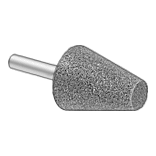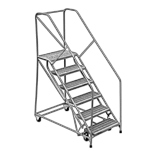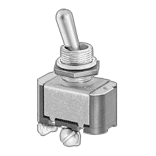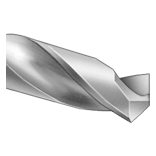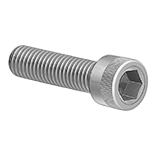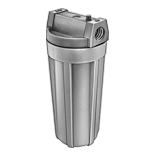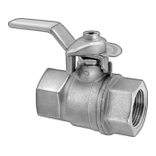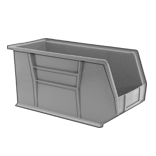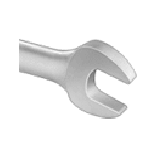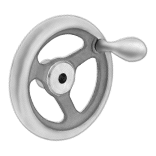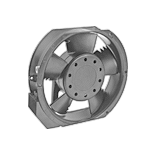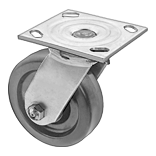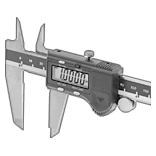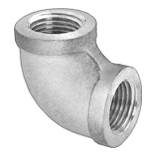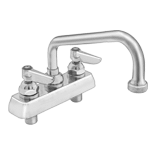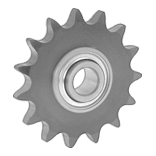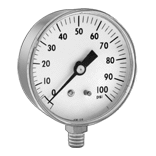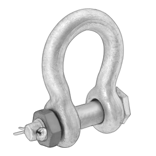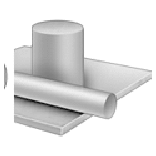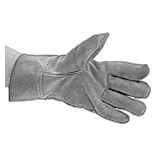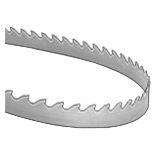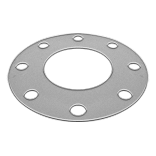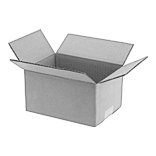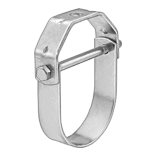Choose the right threaded insert for your application and learn how to install it securely.
About Rod Ends
More
18-8 Stainless Steel Key-Locking Inserts

Made of stainless steel, these inserts have good corrosion resistance. Drive the keys into the surrounding material for a more secure hold than thread-locking inserts. Use them to repair or change threads in soft metals such as aluminum. Inserts may be mildly magnetic. They’re comparable to Keensert inserts. Installation requires a drill bit, a standard tap, an installation tool, and a hammer.
Inserts with an extra-thick wall are stronger than thick- and thin-wall inserts. Use them to reduce the size of tapped holes.
Mil. Spec. 18-8 Stainless Steel Key-Locking Inserts

These inserts are made to stringent military specifications. Drive the keys into the surrounding material for a more secure hold than thread-locking inserts. Use them to repair or change threads in soft metals such as aluminum. Inserts may be mildly magnetic. They’re comparable to Keensert inserts. Installation requires a drill bit, a standard tap, an installation tool, and a hammer.
Inserts with a thin wall are often used in small holes or near the edge of a workpiece.
Choose inserts with a thick wall for greater strength than thin-wall inserts, or to fill a large hole.
Black-Phosphate Steel Key-Locking Inserts

A black-phosphate finish provides mild corrosion resistance. Drive the keys into the surrounding material for a more secure hold than thread-locking inserts. Use them to repair or change threads in soft metals such as aluminum. They’re comparable to Keensert inserts. Installation requires a drill bit, a standard tap, an installation tool, and a hammer.
Choose inserts with a thick wall for greater strength than thin-wall inserts, or to fill a large hole with stripped threads.
Inserts with an extra thick wall are stronger than thick- and thin-wall inserts. Use them to reduce the size of tapped holes.
Inserts | ||||||||||
|---|---|---|---|---|---|---|---|---|---|---|
Each | Installation Tools | |||||||||
| Thread Size | For Tap Thread Size | Installed Lg. | Drill Bit Size | For Max. Hole Dia. | No. of Locking Keys | 1-9 | 10-Up | Each | ||
Black-Phosphate Steel with Thick Wall | ||||||||||
| 1 1/8"-7 | 1 1/2"-12 | 1 5/8" | 1 7/16" | 1 7/16" | 4 | 000000000 | 000000 | 000000 | 000000000 | 0000000 |
| 1 1/8"-12 | 1 1/2"-12 | 1 5/8" | 1 7/16" | 1 7/16" | 4 | 000000000 | 00000 | 00000 | 000000000 | 000000 |
| 1 1/2"-12 | 1 7/8"-12 | 2" | 1 13/16" | 1 13/16" | 4 | 000000000 | 000000 | 000000 | 000000000 | 000000 |
Black-Phosphate Steel with Extra Thick Wall | ||||||||||
| 1"-8 | 1 1/2"-12 | 1 3/8" | 1 7/16" | 1 7/16" | 4 | 000000000 | 00000 | 00000 | 000000000 | 00000 |
Key-Locking Inserts with Installation Tool
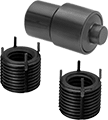
Drive the keys into the surrounding material for a more secure hold than thread-locking inserts. These inserts are used to repair or convert threads in soft metals such as aluminum. They’re comparable to Keensert inserts.
Black-phosphate steel inserts are mildly corrosion resistant.
Choose inserts with a thick wall for greater strength than thin-wall inserts, or to fill a large hole.
| Thread Size | For Tap Thread Size | Installed Lg. | Drill Bit Size | For Max. Hole Dia. | No. of Locking Keys | No. of Inserts Included | Each | |
Black-Phosphate Steel with Thick Wall | ||||||||
|---|---|---|---|---|---|---|---|---|
| 1 1/8"-7 | 1 1/2"-12 | 1 5/8" | 1 7/16" | 1 7/16" | 4 | 2 | 000000000 | 0000000 |
Ball Joint Rod Ends
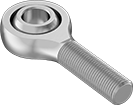

Made of steel, these rod ends generally handle higher loads than stainless steel, aluminum, and nylon rod ends. They don’t come lubricated, so you’ll need to lubricate during installation and on an ongoing basis.
Zinc-plated steel rod ends provide moderate corrosion resistance.
| Shank Thread Size | ID | Max. Ball Swivel | O'all Wd. | O'all Thick. | Shank Center Lg. | Shank Thread Lg. | Static Radial Load Cap., lbs. | Material | Choose a Shank Thread Direction | Each | |
Ball Joints | |||||||||||
|---|---|---|---|---|---|---|---|---|---|---|---|
| 1 1/2"-12 | 1 1/2" | 6.5° | 3 1/2" | 1 5/16" | 5 3/8" | 3" | 64,750 | Zinc-Plated Alloy Steel | 00000000 | 0000000 | |
Internally Threaded Ball Joint Rod Ends

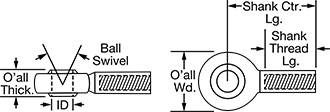
Made of steel, these rod ends generally handle higher loads than stainless steel, aluminum, and nylon rod ends. They don’t come lubricated, so you’ll need to lubricate them during installation and on an ongoing basis.
Zinc-plated steel rod ends provide moderate corrosion resistance.
| Shank Thread Size | ID | Max. Ball Swivel | O'all Wd. | O'all Thick. | Shank Center Lg. | Shank Thread Lg. | Static Radial Load Cap., lbs. | Material | Choose a Shank Thread Direction | Each | |
Ball Joints | |||||||||||
|---|---|---|---|---|---|---|---|---|---|---|---|
| 1 1/2"-12 | 1 1/2" | 6.5° | 3 1/2" | 1 5/16" | 5 3/8" | 2 5/8" | 64,750 | Zinc-Plated Alloy Steel | 00000000 | 0000000 | |
